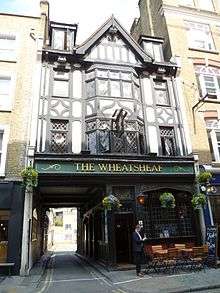Rathbone Place
Rathbone Place is a street in central London that runs roughly north-west from Oxford Street to Percy Street. it is joined on its eastern side by Percy Mews, Gresse Street, and Evelyn Yard. The street is mainly occupied by retail and office premises.



History
The street was originally known as Glanville Street.[1] It was renamed after Captain Thomas Rathbone, who had owned a house on the street since 1684.[2]
Inhabitants
The essayist and critic William Hazlitt lived at No. 12 from 1802 to 1805, while the painter John Constable lived at No. 50 during this time. The sculptor Gilbert Bayes lived at No. 52 from 1899 to 1900.[2]
The music-hall publisher Henri D'Alcorn was based in Rathbone Place: at no. 22A in 1855–7, no. 18 in 1857–60 and no. 8 in 1860–67.
Buildings
On the east side, Number 11 was a grade II listed terraced house, built around 1718–20 and refronted in the nineteenth century. The ground floor was converted to commercial premises.[3] It is now the home of Lazarides Gallery.[4]
On the same side is The Wheatsheaf public house at number 25 which became one of the principal gathering-places of London's bohemian set before the Second World War and where customers included Dylan Thomas.
On the western side of the street was the former Royal Mail depot, which is now One Rathbone Square; it was redeveloped by Great Portland Estates into a mix of residential, office and retail units.[5][6]
A sign on a building for Rathbone Place is seen in the last scene of BBC's Sherlock series 4 finale.[7] This is a nod to the actor Basil Rathbone and the building shown is not part of Rathbone Place.
References
| Wikimedia Commons has media related to Rathbone Place. |
References
- "Rathbone Street", Survey of London, Volume 21, The parish of St Pancras part 3: Tottenham Court Road & Neighbourhood. 1949. British History Online. Retrieved 13 November 2014.
- Weinreb et al. 2008, p. 683.
- Historic England. "Details from listed building database (1265266)". National Heritage List for England. Retrieved 21 November 2018.
- "Lazarides Gallery". Retrieved 21 January 2017.
- Great Portland Estates to develop £550m Rathbone Place project. Chloe Stothart & Tom Fitzpatrick, Construction News, 16 October 2013. Retrieved 7 November 2014.
- Rathbone Square. Great Portland Estates. Retrieved 12 November 2014.
- "Here's The Creators And Notable Cast Of "Sherlock" On That Fucking Intense "Final Problem" Episode". BuzzFeed. 16 January 2017. Retrieved 17 January 2017.
Citations
- Weinreb, Ben; Hibbert, Christopher; Keay, Julia; Keay, John (2008). The London Encyclopedia. Macmillan. ISBN 978-1-4050-4924-5.CS1 maint: ref=harv (link)